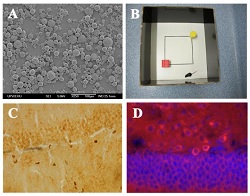 |
| Biodegradable polymeric nanoparticles, a mouse memory test and markers to analyze neurogenesis--Courtesy of UPV/EHU |
Alzheimer's and Parkinson's diseases present major challenges in drug development and delivery. Researchers around the world have searched for an efficient and safe way of delivering treatments to the brain past the protective blood-brain barrier, but with limited success. To this end, scientists in Spain have now developed small particles with the ability to encapsulate and release growth factors when implanted in the brain, ultimately reversing the effects of these diseases by spurring the growth of new, healthy neurons.
The team from the University of the Basque Country says in a release that growth factors that would prevent neuron loss and help form new ones have been difficult to administer with much safety or efficacy.
But by encapsulating the growth factors in particles of both micro and nano sizes--made of poly (lactic co-glycolic acid)--and implanting them in the brain directly, the drugs bypass the blood-brain barrier entirely for two to three months, according to the university.
"Growth factors are encapsulated so that they can be administered more effectively and more safely," lead author Enara Herran said in a statement. "In other words, they are inserted into micro and nanocapsules and implanted in the brain by means of craniotomy. That way, the drugs would be released right where they have to act, and what is more, in an ongoing and in the correct dose."
In studies performed in rats and mice, the encapsulated form was more effective than oral drugs for Alzheimer's and Parkinson's. In the experiments, use of the vascular endothelial growth factor and the glial cell-line derived neurotrophic factor showed improvement in comparison with the control group, the scientists say, testing both for memory function and neurogenesis.
The results were published in the Journal of Controlled Release. Currently, the team is working to make the treatment work without the need for a direct implantation in the brain.
- here's the release